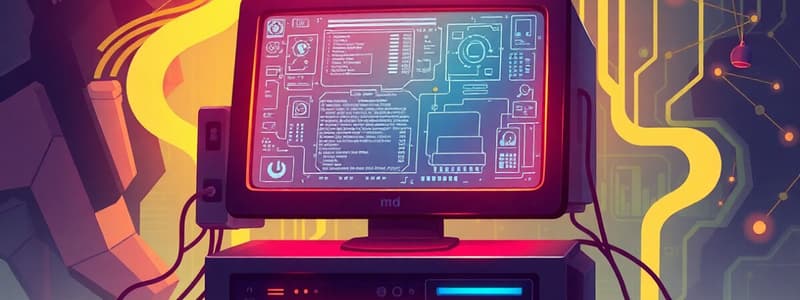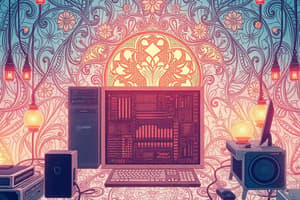Podcast
Questions and Answers
How do programs relate to the actions a computer performs?
How do programs relate to the actions a computer performs?
- Programs enhance the computer's processing speed but do not dictate specific tasks.
- Programs follow the instructions called computers.
- Programs are a suggestion to a computer, but the computer decides what to do.
- Programs dictate the specific tasks a computer will perform. (correct)
Which sequence accurately represents the IPOS cycle?
Which sequence accurately represents the IPOS cycle?
- Storage, Input, Processing, Output.
- Input, Output, Processing, Storage.
- Processing, Input, Storage, Output.
- Input, Processing, Output, Storage. (correct)
What distinguishes information from data?
What distinguishes information from data?
- Information is used for storage, whereas data is for communication.
- Data includes audio and video, while information is only text.
- Information is raw and unorganized, while data is structured.
- Data is processed to become information. (correct)
Which of the following is the best description of 'hardware'?
Which of the following is the best description of 'hardware'?
System software's primary function is to do what?
System software's primary function is to do what?
Which of the following is considered application software?
Which of the following is considered application software?
Where would internal hardware typically be located?
Where would internal hardware typically be located?
If a user is creating a report, which type of software would they use?
If a user is creating a report, which type of software would they use?
Which of the following is NOT an example of an input hardware?
Which of the following is NOT an example of an input hardware?
Which of the following is NOT an example of System Software?
Which of the following is NOT an example of System Software?
Where might you find an embedded computer?
Where might you find an embedded computer?
Which characteristic is most indicative of mobile devices?
Which characteristic is most indicative of mobile devices?
What is another common name for personal computers (PCs)?
What is another common name for personal computers (PCs)?
What is the primary role of servers in a network environment?
What is the primary role of servers in a network environment?
Which of the following best characterizes mainframe computers?
Which of the following best characterizes mainframe computers?
What makes supercomputers stand out from other types of computers?
What makes supercomputers stand out from other types of computers?
Which of the following uses an embedded computer?
Which of the following uses an embedded computer?
Which is the definition of mobile devices?
Which is the definition of mobile devices?
Which of the following is not an example of the Personal Computer?
Which of the following is not an example of the Personal Computer?
Which is another name which Mainframe Computers are called?
Which is another name which Mainframe Computers are called?
Flashcards
What is a computer?
What is a computer?
An electronic device programmable to accept data (Input), save data (Storage), convert data (Processing), display results (Output), and communicate.
IPOS Cycle
IPOS Cycle
The basic operations of a computer: Input, Processing, Output, Storage and Communication.
What is data?
What is data?
Raw unorganized collection of facts.
What is Information?
What is Information?
Signup and view all the flashcards
What is hardware?
What is hardware?
Signup and view all the flashcards
What is Software?
What is Software?
Signup and view all the flashcards
System Software
System Software
Signup and view all the flashcards
Application Software
Application Software
Signup and view all the flashcards
Personal Computers (PCs)
Personal Computers (PCs)
Signup and view all the flashcards
What are Servers?
What are Servers?
Signup and view all the flashcards
Mainframe Computers
Mainframe Computers
Signup and view all the flashcards
What are Super Computers?
What are Super Computers?
Signup and view all the flashcards
What are Embedded Computers?
What are Embedded Computers?
Signup and view all the flashcards
What are Mobile Devices?
What are Mobile Devices?
Signup and view all the flashcards
Internal hardware
Internal hardware
Signup and view all the flashcards
External hardware?
External hardware?
Signup and view all the flashcards
Study Notes
Basic Terminology
- The key topics covered include basic terminology, data and information, key components of a computer, and major computer types.
Computer Definition
- A computer is an electronic device programmable to accept data as input.
- It saves data and information (storage), and converts data into useful information (processing).
- The computer displays results (output) and sends data/info to others (communication).
- Computers follow instructions called programs that determine tasks.
Basic Computer Operations
- Input, Processing, Output, Storage, and Communication make up the basic operations.
- These operations are known as the IPOS Cycle.
Data and Information
- Data is a raw, unorganized collection of facts.
- Information is the result of processing data into a meaningful form.
- Both data and information can be in the form of text, sound, graphics, or video.
- The processing converts data into information.
Key Computer Components - Hardware
- Hardware includes the physical, tangible components.
- Internal hardware is located inside the system unit of the computer.
- External hardware exists outside the system unit.
- It connects via wired or wireless connections.
- All five computer operations require such hardware.
Key Computer Components - Software
- Software is non-physical and intangible.
- Software includes the programs or instructions that control the hardware.
- System Software is utilized to operate the computer.
- Application Software allows users to perform specific tasks.
Hardware Examples
- Input devices: keyboard, mouse, microphone
- Processing: CPU, GPU
- Output devices: Screen, Printer, Speakers
- Storage: Flash Disk, Hard Disk, DVD Drive
- Communication: Router, Modem
Software Examples
- System Software: Microsoft Windows 10, iOS, Android
- Application Software: Microsoft Office 2016, Adobe Photoshop, Real Player, WhatsApp
Major Computer Types
- Computers are classified as embedded computers, mobile devices, personal computers, servers, mainframe computers, and supercomputers.
Embedded Computers
- Embedded computers perform specific tasks within a device.
- They are found in household appliances, thermostats, treadmills, answering machines, and cars.
Mobile Devices
- Mobile devices are small, handheld or wearable with built-in computing and/or internet.
- Examples include smartphones, handheld gaming devices, mini tablets, and smart watches.
Personal Computers (PCs)
- PCs are small computers designed for one person's use at a time.
- Also known as microcomputers, and come in different shapes and sizes.
- Examples include desktop computers, laptops/notebooks, and hybrid notebooks/tablets.
Servers
- Servers are midrange computers that provide services to a group of users.
- These services include data storage and accessible programs.
- Users connect to servers using other computers.
- Servers are used by almost all organizations.
Mainframe Computers
- Mainframe computers are powerful and used by large organizations to manage centralized data.
- They are also called high-end or enterprise-class servers.
Supercomputers
- Supercomputers are the fastest, most expensive, and most powerful computers.
- Supercomputers generally run one program at a time, as fast as possible.
- The TITAN supercomputer contains over 300,000 processors.
- TITAN has a peak speed of 17.59 quadrillion calculations per second.
Studying That Suits You
Use AI to generate personalized quizzes and flashcards to suit your learning preferences.




